The Interreligious Gathering of Prayer for World Peace, a three-day meeting of the world's religious leaders dedicated to enhancing world peace was held from August 2 through 4 in 1997 at the Kyoto International Conference Hall, Kyoto, and at Mt. Hiei. The meeting was held to commemorate the 10th Anniversary of the Religious Summit Meeting on Mt. Hiei which was held in 1987 and was attended by a total of 2000 participants from 19 countries. Prominent among them were representatives from major religions and religious organizations from around the world with he Konko Church of
Izuo represented by the Rt. Rev. Tatsuo Miyake and his two sons, Reverends Mitsuo and Yoshinobu.
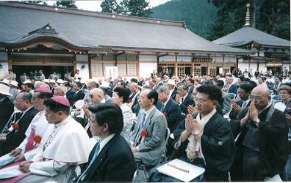 |
The Memorial Lectures were lead by Yasushi Akashi, Under Secretary-General of the United Nations. Speaking on "World Peace and Human Wisdom," he stressed that the degree in which world peace can be achieved depends upon the individual's consciousness. This is because the main cause of wars is the intolerance of humans which is at times spawned by differences in religious perspectives. He emphasized that realistic approaches should be followed by people to bridge these gaps and universal values be established. He ended his speech by strongly advocating that group violence not be tolerated by individuals.
His Eminence Francis Cardinal Arinze noted in his speech entitled "Religious Co-operation and Reconciliation between Peoples" that reconciliation among people of different backgrounds should play the key role in achieving world peace. Wars are not unavoidable he says. The ability to forgive and to beg for mercy are the two important elements that people must have in order to achieve world peace, as is the fact that people should love their neighbors in the biblical sense. He firmly believes that through
religious protools, peace can be the more smoothly achieved and says that the 21st century is the century of reconciliation, and its promotion the work of religionists.
During the lunch and coffee breaks, the Rt. Rev. Tatsuo Miyake and his sons greeted old friends and renewed acquaintances as many familiar faces were to be found among the participants not the least being Dr. William F. Vendley, Secretary General of the World Conference on Religion and Peace (WCRP) and Dr. Robert Traer, Secretary General of the International Association for Religious Freedom (IARF). The Rt. Rev. Tatsuo also took the opportunity to thank Yasushi Akashi for his decade-long service with the United Nations and his efforts to bring peace to the troubled areas of the world. The Reverend then introduced his son, Mitsuo saying "the changing of the guards is taking place at our church too."
Later in a conversation with Professor David Rosen, Director of Interfaith Relations, Anti-Defamation League (ADL), Israel, the Rt. Rev. Tatsuo reaffirmed the need to further promote the presence of WCRP and to establish local offices which would operate as interfaces between religious groups. In parting, Prof. Rosen hoped that the next meeting to be held in Jordan in 1998 would be a success too.
The Ceremony of the Interreligious Prayer for World Peace took place on August 4 at Enryakuji Temple of the Tendai Buddhist Denomination located in Mt. Hiei. Representing ten religions and religious organizations from around the world, the delegates proceeded single file to the prayer site set up in front of the temple's main hall. Following the Opening Remarks made by Reverend Tsunekiyo Tanaka, the Peace Bell was rung while all present bowed their heads in a three minute silent prayer for world peace.
As Honorary President of the Japan Conference of Religious Representatives (JCRR), the Most Venerable Eshin Watanabe, who is also the Supreme Priest of the Tendai Buddhist Denomination, warmly welcomed the delegates saying that he was pleased to note that this historical meeting has greatly increased cooperation and understanding among religionists. He added, however, that the world situation still remains problematic. He therefore urged that the prayers be more powerful and heartfelt so that god's love and compassion could be felt throughout the world.
Following these words of greetings, each religion and religious organization came on stage one after the other to read a prayer for world peace. The strangely beautiful sound of prayers read in different languages, served to underline the differences in religious practices to all present, yet providing beyond doubt that such differences could be overcome as witness the meetings.
The "Message from Mt. Hiei" was read by Seiichi Cardinal Shirayanagi, President of JCRR and the Japan Committee for the World Conference on Religion and Peace. This was followed by the Closing Remarks of the Venerable Ryusho Kobayashi.
Later at Hieizan Hotel where a Farewell Party was held, the Rt. Rev. Tatsuo Miyake of the Konko Church of Izuo mingled with the delegates, exchanging words of greeting with old and new family friends. In his talk with Dr. Salih M. Al-Samarrai of the Islamic Center, he learned that it was Dr. Al-Samarrai's third meeting and that with each occasion, the number of religionists attending had increased. This he said was most pleasing as the meeting offered them a real opportunity to overcome religious differences.
With Dr. A. T. Ariyaratne, President of the Sarvodaya Shramadana Movement, Sri Lanka, conversation waxed over a shared concern - orphans and orphanages in the island state. Dr. Ariyaratne knew Reverend Tatsuo's father and of the orphanage that had been constructed by the Izuo Church as his organization is also involved in building orphanages and schools. In fact, their organization is second only to that of the government as sponsors of such facilities. However, he said hat in his country, the problem was not so much religious as political for at his organization's facilities, children of Singhalese, Tamil and Islamic backgrounds live together in peace and harmony. A cordial invitation was issued to the Reverend to visit Sri Lanka, and was reciprocated in kind.
His Eminence Mar Gregorios Yohanna Ibrahim, Metropolitan of Aleppo (Syrian Orthodox Church), revealed that he had come to Japan to learn from the Japanese how to co-exist in peace and harmony as given the great number of different religions practiced in the nation, it was an excellent role model for his country which is beleaguered by religious conflicts between the Palestinians and Israelis. An invitation was again issued to the Reverend to visit Damascus.
Ā° International Religious Fellowship of Osaka
Several important and enlightening symposia have been held in the past few
To help celebrate the 50th anniversary of the IRFO's creation, former Sudanese Ambassador to Japan, Dr. Musah Muhammad Omar gave a presentation in October, 1997, comparing the religious architecture of the Islamic world to that of Japan's.
In February, 1999, Pema Gyalpo, Chief of the Tibetan Institute in Japan spoke on the issues of religious freedom in Tibet under communist rule. Gyalpo found it necessary to flee his homeland with the Dalai Lama when Chinese troops entered Tibet.
The IRFO was also fortunate to be able to present a talk by former Russian Consul General in Osaka, Dr. Georgie Komarovski. Dr. Komarovski is a noted historian with a diplomatic career that has stretched over 30 years. He gave a lecture on the problems caused by the fundamentalist Islamic challenge to the Russian Federation in nations along the southern border of Russia. His talk was all the more pertinent in view of the current crisis inside Russia in the Chechnya region.
Ā° Miyake HomeĀ@Ā@
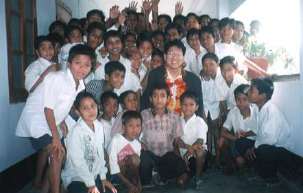 |
In some nations where religious fundamentalism has a strong influence, any reference to Shintoism or another religion might lead to tension.
The Rev. Mitsuo Miyake also visited Bangladesh in 1999 and donated money in order to construct a library. A donation was also made to help repair a damaged roof on one of the homes caused by a severe storm. The Rev. Miyake had also wished to visit Katmandu, Nepal, where there is another Miyake Home but he was unable to do so because of an airline strike in India.
There are at least 300 children residing at the Miyake home there and the educational level is such that it is considered one of the top schools in Nepal. The facilities also help children improve themselves through better health services and practices.
The Izuo Church has a long history of taking children's interests into account and providing for their welfare. In this way the Church hopes to raise the standard of living among the poorest children of South Asia. At any given year, up to 2,000 children are cared for and educated at Miyake Homes. The Church believes that these children will have brighter futures.
Ā° The Spiritual Aspect of Environmental Protection
The Rev. Yoshinobu Miyake discussed the Conferences of Parties to the United Nations Framework Convention on Climate Change (COP), specifically COP3 which was held in Kyoto in 1997. The Rev. Mitsuo Miyake has attended a number
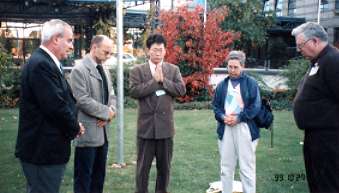 |
As Konko Church of Izuo is concerned about environmental issues world-wide and the continued degradation of the environment, the Rev. Mitsuo Miyake is making great efforts to get political and business leaders to consider the earth's resources from a spiritual point of view. Although COP3 set carbon emission reduction rates for many of the world's leading industrial nations totaling a 5 percent reduction compared to 1990 levels. the Rev. Yoshinobu Miyake feels the decisions based on political or industrial concerns miss the point of resource conservation.
The Shinto religion stresses a harmony with nature, as do other Eastern spiritual philosophies such as Taoism. The Reverends Miyake feel that this natural, spiritual philosophy must be brought to bear on the minds of the world's political decision-makers. The Rev. Yoshinobu Miyake believes that even if we have enough resources to use, we should not ignore conservation. We need to control ourselves so as not to live out of balance with nature. The Rev. Mitsuo Miyake has taken this message to other religious leaders around the world, pointing out that environmental protection is foremost a spiritual problem, not a political or economic one. During the COP3 Conference, the Rev. Mitsuo Miyake invited Argentinean Ambassador Estrada, Congress Moderator to join him and other Japanese religious leaders at a Catholic church in Kyoto to emphasize the religious connection to the problems of global warming, pollution and other forms of environmental waste and destruction.
While attending each of the above-mentioned COP meetings, has led prayer servicesĀ@to draw attention to this concept.
Ā° World Federalist Movement Holds 23th World Congress in India
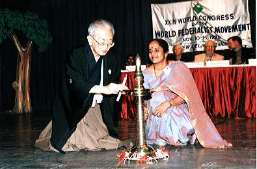 |
In 1980, the Rt. Rev. Tatsuo Miyake attended as President of the World Federalist Asian Center (WAC). The WFM holds a different view for the United Nations than that which presently exists. Under the current system nation-states hold power much like the old League of Nations that was created after World War I. The Rev. Yoshinobu Miyake points out that this organization failed to prevent the second World War from occurring.
Therefore, the WFM calls for a World government under a system of Global Democracy to be formed.
The Rev. Mitsuo Miyake also attended the 23rd Congress as President of the Asian Youth Center (AYC). All money used to support the AYC and the Asian Center of the WFM come from financial contributions by Konko Church of Izuo. These contributions help orphans and street children throughout Asia.
A notable absence from the WFM, India was Indian Prime Minister Vajpae. As the WFM is a strongly anti-nuclear organization, the Indian and Pakistani nuclear tests 6 months earlier may have caused the Prime Minister to reconsider his appearance before the Congress.
Speakers at the 23rd World Congress included Sir Peter Ustinov, Bishop Ezra
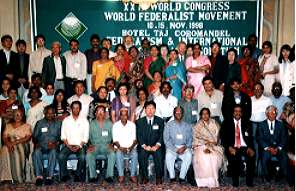 |
Some highlights of the Congress included cultural events where the Indian hosts provided the attendees a chance to experience South Asian cuisine, as well as tours of the Taj Mahal, the Red Fort, and the model Indian village of Chitra. The Rt. Rev. Tatsuo Miyake took part in the opening ceremony by lighting a lamp on the stage. This symbolized the unity amidst diversity of world federalism. Dramatic Indian dances where performed by the world class troupe, Bharata Kalanjali.
Sir Peter Ustinov, actor, author and political commentator, was unanimously reelected as President of the WFM and Senator Lois Wilson, President of the World Federalists of Canada was elected as WFM Vice-President. In addition, the World Federalists of Germany were recognized as a member organization of the WFM. A meeting of South Asian NGO's on nuclear disarmament, social development and human rights was held under the Hague Appeal for Peace on November 11.
Future actions related to the Appeal were planned. Also, several Asian Regional Meetings took place among Indian, Nepalese, Japanese and other Asian World Federalist representatives in Chennai. They began setting the groundwork for future cooperation by the Rev. Mitsuo Miyake of AYC president.
Ā° Rev. Mitsuo Miyake Tours South and South East Asia
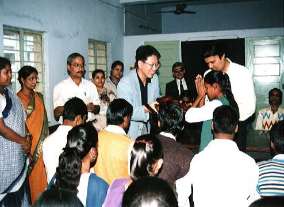 |
Another important decision of the meeting was to increase networking within each national chapter by setting each first Monday of the month as the day when e-mail information would be exchanged among the domestic chapters. Prior to this decision, there had only been once a year contacts made from the headquarters in each nation.
Ā° Final Meeting with The Most Rev. Toshio Miyake
The 1999 Board Meeting of the World Conference on Religion and Peace (WCRP)/Japan was held in Osaka in March 29. Many Japanese religious leaders were in attendance at the Konko Church of Izuo to discuss issues concerning the World Assembly as it related to Japan. But the most important aspect of this gathering was that some of the religious leaders had a final chance to meet the Most Rev. Toshio Miyake who passed away several months later.
The Most Rev. Toshio Miyake founded the WCRP in 1970 when the First Assembly was held in Kyoto that year. He served the organization for 29 years until his passing. His hard work and guidance helped bring about all seven of the World Assemblies. The second was held in Leuven, Belgium, and was followed by assemblies in Princeton, United States, Nairobi, Kenya, Melbourne, Australia, Rome and Riva de Garda, Italy, and this year in Amman, Jordan -- the first time for the assembly to be held in an Islamic nation. This was a particularly satisfying situation as Islamic nations had not shown much interest in inter religious interaction previously. He served as President for ten years between 1984-1994 and was chairman of the Finance Committee since the organization came into existenceĀD
Ā° Rev. Yoshinobu Miyake visits Mongolia
The Konko Church of Izuo has had a long-running relationship with the Buddhist community of Mongolia which goes back over 40 years. Even in times of Communist oppression when Buddhism could not be practiced openly,Izuo Church kept up its relations.
In July 1999, the Rev. Yoshinobu Miyake traveled to Ulan Bator to work with the
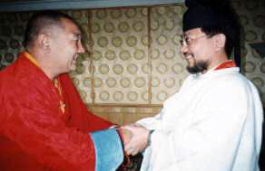 |
The IRFO decided last year to establish a fund to support the Buddhist organizations need to hold onto their religious and historical resources. Additionally, some of the money will also help finance the publication of new Buddhist literature.
Ā° Donations for Disaster Relief to Turkey and Taiwan
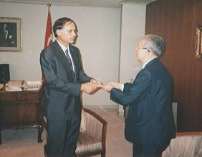 |
Ā°International Association for Religious Freedom holds 30th Congress in Canada
The International Association for Religious Freedom (IARF) held it's 30th World Congress at the University of British Columbia in Vancouver, Canada from July 29 - August 3, 1999. The Association started 99 years ago in Boston, the United States and is the oldest inter-religious organization in the world. The main goal of the IARF is to uphold religious rights for minority communities. Prior to World War I the Association held Congresses in Europe and the U.S. that attracted thousands of participants. Between the two world wars the IARF struggled to define a liberal Christian vision of liberty and tolerance, and after World War II the Association embraced a pluralistic view of the world's religious diversity. Since the end of the Cold War the IARF has given greater emphasis to supporting religious freedom as a human right.
The theme for this year's meeting was, Creating an Earth Community: a Religious Imperative. The Rt. Rev. Tatsuo Miyake acted as one of the international council members and The Rev. Yoshinobu Miyake was a co-moderator of one of the six study groups, sharing the honor with Dr. Gene Reeves. Among the myriad of cultural performances and study groups, Konko Church members were involved in several events.
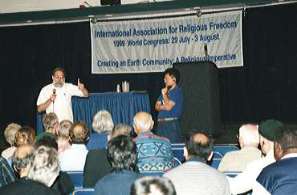 |
The IARF Secretariat hosted a discussion with representatives of other international interfaith organizations entitled, Interfaith Strategy: What interfaith efforts should the IARF support? The Rev. Yoshinobu Miyake was also attended this discussion as a speaker. It was pointed out in this meeting that the IARF is the oldest international interfaith group but by no means the only international interfaith group. Other organizations are engaged in international strategies on behalf of interfaith understanding and cooperation. The following questions were presented for consideration. What are their strategies? What are the difficulties they seek to overcome? What have they learned from their mistakes and successes? Are there possibilities now for new international initiatives?
Other activities and presentations included these two study groups which served by the Rev. Yoshinobu Miyake. Other environmental and religious freedom issues were raised by numerous speakers from around the globe. Shinto ceremony and cultivation of Spirituality discussion was also presented. Cultural events presented at the Congress included songs by David Campbell (First Nations), Moshe Dunburg (Jewish), and Joyce Poley (English Canadian). Lan Tung played the "er-hu", a Chinese fiddle and he was joined by James Hamilton who used a sitar in an Asian cross-cultural duet. Fanny Starchild (French Canadian) provided music and humor.
On August 1, Japanese participants invited other Congress members to join in a
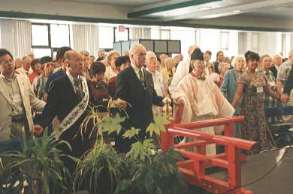 |
The Konko Church of Izuo had a special role to play at the congress. Every morning, as part of the interfaith service, Konko devotions were offered by the Rt. Rev. Tatsuo Miyake along with other ministers of Konko churches from Vancouver and Los Angeles. The Konko Church has almost 100 year history in North America with more than 10 churches in existence.
Ā°World Conference on Religion and Peace holds the 7th World
Assembly in Jordan
The 7th World Assembly of the World Conference on Religion and Peace (WCRP) was held in Amman,
On the 26th of November, three major religious leaders from Bosnia-Herzegovina spoke at the conference, including Reisu-l-Ulema Mustafa Ceric of the Islamic Community, Metropolitan Nikolaj Mrdja of the Serbian Orthodox Church, and Vinko Cardinal Puljic of the Roman Catholic Church. They all agreed that religious leaders should refrain from verbal attacks on other ethnic groups.
Also on the 26th there were six major actions discussed by the Six Assembly Commissions.
1) Action for the Child and the Family. Taking into account the statement of the WCRP International Governing Board's statement, "Each of our religious traditions affirms the sanctity and promise of the child. If we fail to protect our children, we deny our humanity, risk our future and betray our beliefs", this Commission discussed strategies to mobilize the spiritual, moral, and institutional resources of religious communities, working independently and in collaboration to ensure survival, protection, and development of children. Child-related concrete cases from WCRP International Projects such as the demobilization and social reintegration of child soldiers and camp followers will be closely examined in order to further develop strategies to mobilize the spiritual, moral, and institutional resources of religious communities for the well-being of children around the world.
2) The Commission on Conflict Transformation and Reconciliation examined the strategies to mobilize spiritual, moral, and institutional resources of the religious communities around the world for conflict transformation. Conflict transformation initiatives undertaken by WCRP in Bosnia, Kosovo, Sierra Leone and Indonesia were carefully looked at in order to further develop WCRP's strategies to mobilize the spiritual, moral, and institutional resources for religious communities for conflict transformation. The Commission members were guided by the words of the First Assembly on Religion and Peace in Kyoto in 1970, "As men and women of religion, we confess in humility and penitence that we have very often betrayed our religious ideals and our commitments to peace. It is not religion that has failed the cause of peace, but religious people. ThisĀ@betrayal of religion can and must be corrected."
3) The Commission on Sustainable Development and Ecology discussed the concept that religious communities have a natural and profound role to play in promoting sustainable development and preserving ecology if their unique moral and institutional assets are effectively and creatively mobilized. The Commission will provide an ongoing forum to: synthesize current research and technical material relevant to engaging religious communities in poverty eradication and sustainable development; document significant cases of religiously motivated relief and development activities, particularly those involving multi-religious collaboration; and seek to build greater interaction and cooperation between religiously-based relief and development organizations.
4) The Commission on Disarmament and Security examined the potential role for multi-religious collaboration in preventing weapons proliferation. The activities undertaken by the Standing Commission on Disarmament and Security were examined. A key element of the Standing Commission's program has been to build a coalition of religious institutions to speak with a common voice during the United Nation's Preparatory Committee of the Non Proliferation Treaty. In the field of conventional arms WCRP is working with delegates of the UN's First Committee exploring ways of collaborating closely with WCRP's Assembly Project on Small Arms. These activities reflect the words of WCRP founder and President Rev. Nikkyo Niwano, "It is my firm belief that religion alone can provide the motivational power to create a peaceful world, not through armed might, but through respect of humanity."
5) The Commission on Human Rights and Responsibilities explored the potential of religious communities in relationship to Human Rights. The Commission closely examined human rights initiatives in WCRP International Projects in Bosnia and Sierra Leone, which explored the Role of Religion in Developing a Human Rights Culture. WCRP mounted a comprehensive human rights program designed to mobilize the religious communities' capacities for advocacy for human rights, building on the Statement of Shared Moral Commitment, with its clear declaration of common ground between the four historical religious traditions in Bosnia-Herzegovina and its call for the
fundamental human rights and freedoms of all to be upheld.
6) The Commission on Peace Education explored the potential of religious communities in relationship to Peace Education. The Peace Education Standing Commission has been examining and supporting inter-religious peace education initiatives in three main areas: Religious and Inter-religious Education; Education towards violence-free communication and conflict solution; Environmental education and education toward socio-economical development. The Commission examined the activities undertaken by the Standing Commission and further developed strategies to the role of religions in peace education.
The program for the 27th of November was much more academic and cultural. It included a talk by the former President of Costa Rica, Dr. Rodrigo Carazo who is a good friend of the Most Rev. Tatsuo Miyake. Konko Church of Izuo has donated a hall to United Nations Peace University in Costa Rica. He spoke about the fact that Costa Rica has no standing state military.
On the 28th a video presentation was given by WCRP with the President H.E. Ahmad Tejan Kabbah of the state, showing the important role that the organization played in helping to bring to an end a senseless and bloody civil war in Sierra Leone. The morning session also included Forum Reports from South East Europe and Indonesia, in addition to a report from the Japan Summit 21.
The highlights of the final day, the 29th of November, included the election by the Assembly of
The 7th World Assembly of the the World Conference on Religion and Peace ended with the memorial chant for the late Most Rev. Toshio Miyake, founding president of WCRP by Buddhist priests from around the world.
Ā°Rev. Yoshinobu Miyake as Scholar
The Rev. Yoshinobu Miyake of Konko Church of Izuo has among his duties, the responsibility of disseminating information about Japanese culture and religion as a learned scholar.
In this function he spoke at SOAS, the University of London, England on
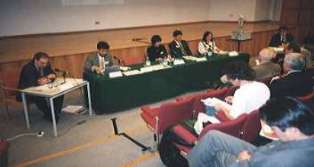 |
Ā° Support the Middle East Peace Process
We, Konko Church of Izuo have made every effort in purpose of promoting the realization of the world peace, especially for the settlement of religious conflicts, through founding the international organizations such as the WCRP (World Conference on Religion and Peace) established by the former Chief Minister and other religious leaders in 1970. We feel deep sorrow about the armed crash between Israeli army and Palestinian citizen and both governments outbreaking just before concluding the comprehensive peace treaty. Under this situation, we devoted ourselves in the effort in order to settle the conflict by using our religious network.
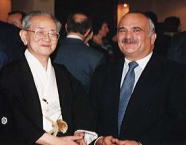 HRH Prince El Hassan of Jordan and the Most Rev. Miyake |
In reply to appeal of HRH Prince El Hassan bin Talal of the Kingdom of Jordan who was appointed to Moderator of the WCRP in November 1999, the Most Rev. Tatsuo Miyake, Senior Chief Minister of Konko Church of Izuo serving as an Honorary President of the WCRP, expressed his support for him immediately after he received e-mail from Prince Hassan. They exchanged their opinions when the Most Rev. Miyake visited Amman in 1999. Moreover, in order to promote the peace process, the former Chief Minister Toshio Miyake had meetings with each high leaders from Judaism, Christianity, and Islam in 1994 when he visited Jerusalem and West Bank. He also realized to deliver the relief goods to Bosnia and Herzegovina under the violently situation by the volunteer group organized the youth from these three religions. It aimed to make them recognize how fruitless the religious and ethnical conflict is.
The following is the document that the Most Rev. Tatsuo Miyake expressed his support for HRH Prince Hassan.
|
Ā°Konko Church of Izuo Donates for Victims of the Great Earthquake
Konko Church of Izuo makes an appeal for public to donate for victims of the terrible earthquake occurred in El Salvador in the Central America and Gujarat state in western India. Members of Izuo Church decided to aid people in the disaster area just after the news program reported that many people were killed or lost family and house.
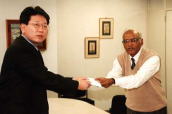 |
As one of the first action, Rev. Mitsuo Miyake, Chief Minister Designated of Izuo Church, handed \200,000 (approx. $2,000) to the board of WCRP (World Conference of Religion and Peace) Japan Committee on 25 January, in order to express their support for its aid campaign. He also visited the Indian Consulate General at Osaka on 31 January and handed \300,000 (approx. $3,000) to Vice Consul General J.C.Goel. Rev. Miyake was explained the present situation in the disaster area in detail.
Izuo Church has continued relief activities to victims of natural disasters, conflicts, and poverty for many years in cooperation with WFM (World Federalist Movement) Asian Center. Especially, Izuo Church has run schools and homes for orphans in the various areas in Indian subcontinent for many years. It donated \3,290,000 (approx. $32,900) in 1999 and 2000, for victims of Colombia Great Earthquake, Turkey Great Earthquake, Taiwan Great Earthquake, and flood in Venezuela through Jinrui Kyoei-kai (Association for Prosperity for Humankind), the non-governmental aid organization.
Ā°Ā@50th Year Anniversary of
Jinrui Kyoei-kai
On 13 January, Jinrui Kyoei-kai (Association of Prosperity for Humankind)
held the General Meeting and a symposium with 200 attendees to commemorate
its 50th year since the foundation. Jinrui Kyoei-kai has continued relief
activities around the world supported by Konko Church of Izuo.
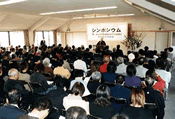 Rev. Tatsuo Miyake delivered an opening address |
At the General Meeting, Mr. Harumi Kawashima, a permanent executive, reported activities and finance in 2001 and submitted the plan in 2002. Then Rev. Mitsuo Miyake, Chair of executives, gave a speech on his administrative policy.
Following the General Meeting, 50th year anniversary symposium was held. Jinrui Kyoei-kai was found by the late Rev. Toshio Miyake, the former Senior Chief Minister of Izuo Church, in 1952 when Japan herself was still in the process of recovery from the destruction of World War II.
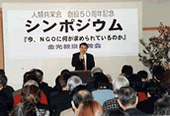 Dr. Suganami lectured aggressively |
Following an opening address delivered by President Tatsuo Miyake, Dr. Shigeru Suganami, the Founder of the Association of Medical Doctors of Asia (AMDA) gave a lecture titled "What required to NGO in today." He lectured aggressively based on his experience in abroad and emphasized the increasing importance of Religious Non Governmental Organizations.
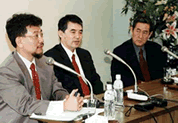 Panelists: Rev. Yoshinobu Miyake, Dr. Shigeru Suganami, Prof. Akio Inoue |
Considering his lecture, the discussion was moderated by Rev. Yoshinobu Miyake, Chief Minister of Konko Church of Kasugaoka, inviting a panelist, Pror. Akio Inoue, Diroctor of Oyasato Institute of Tenri University, whose dialogue activity with Afghanistan guerrilla is highly appreciated by United Nations.